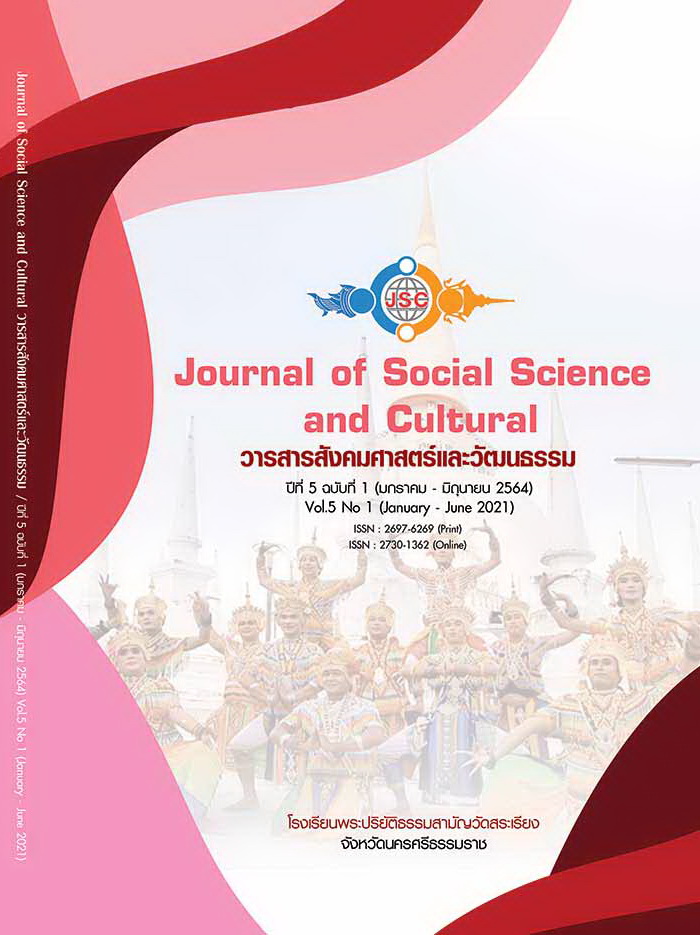CHAIYA COMMUNITY SELF-MANAGEMENT INNOVATION FOR ECONOMIC STABILITY BASED ON COMMUNITY CULTURE
Main Article Content
Abstract
The purpose of this research study is: 1) self-management of the occupational community according to the sufficiency economy guideline and 2) to search for an innovative model of professional development self-management for the stability of the community economy based on community culture. This research was a qualitative research use study of documents, field study, in-depth interviews and focusgroup. Select purposive sampling divided into 4 groups: 1) government agencies at district level, 2) government agencies at local level, 3) academics and 4) people general total 10 persons. By using the analytical study to the integration and creation of new knowledge. The research results found that: 1. The self-management of the community emphasizes the cultural way based on the sufficiency economy. Villagers mainly work in farming. And farming as a supplement Such occupations changed from subsistence production to designs for sale. Focus on operating with professional groups It aims to create stability and well-being of the people in the community. The Chaiya community occupation groups were 1) the Pawe sub-district occupation group, 2) the Thung sub-district community occupation group, and 3) the Lamet sub-district occupation group. And 2. an innovative model of occupational self-management for the stability of the community economy based on community culture is an appropriate career development model for the stability of the community economy based on community culture has 6 important components such as: 1) leadership component, 2) Composition of professional, 3) Productivity component, 4) community adaptation component, 5) Thinking element, and 6) community self-management component. There is learning and succession within the community to suit the changing situation of the community.
Article Details
References
ChaiyaTravel. (2563). ประวัติไชยา. เรียกใช้เมื่อ 14 พฤศจิกายน 2563 จาก https:// sites.google.com/site/ chaiyatravel/prawati-meuxng-chiya
โกวิทย์ พวงงาม. (2553). การจัดการตนเองของชุมชนและท้องถิ่น. กรุงเทพมหานคร: คณะสังคมสงเคราะห์ มหาวิทยาลัยธรรมศาสตร์.
บุญชม ศรีสะอาด. (2556). วิธีการทางสถิติสำหรับการวิจัย เล่ม 2. กรุงเทพมหานคร: สุวีริยาการพิมพ์.
พิชณิชา นิปุณะ. (2554). นวัตกรรมเพื่อชุมชน สู่การพัฒนาอาชีพอย่างยั่งยืน. เชียงใหม่: คณะวิทยาศาสตร์ มหาวิทยาลัยแม่โจ้.
พิชัย มุสิกะ (ชาวบ้าน). (20 กุมภาพันธ์ 2563). นวัตกรรมการจัดการตนเองของชุมชนไชยาเพื่อความมั่นคงทางเศรษฐกิจบนฐานวัฒนธรรมชุมชน. (ชนัญชิดา ทิพย์ญาณ, ผู้สัมภาษณ์)
ศูนย์ข้อมูลประเทศไทย. (2563). อำเภอไชยา. เรียกใช้เมื่อ 14 พฤศจิกายน 2563 จาก http://suratthani.kapook.com /%E0%B9%84%E0%B8%8A%E0%B8%A2% E0%B8%B2
สํานักงานเลขานุการ คณะกรรมการส่งเสริมวิสาหกิจชุมชน. (2563). ความหมายของวิสาหกิจชุมชน. เรียกใช้เมื่อ 14 พฤศจิกายน 2563 จาก http://www.sceb.doae.go.th/ Ssceb2.htm#%E0%B8
สำนักงานคณะกรรมการพิเศษเพื่อประสานงานโครงการอันเนื่องมาจากพระราชดำริ. (2555). เศรษฐกิจพอเพียงปรัชญาชี้ถึงแนวทางการดํารงชีวิต. (พิมพ์ครั้งที่ 6). กรุงเทพมหานคร: บางพลัด.
สุภาพร ภู่ไพบูลย์. (2558). การจัดการชุมชนตามแนวทางเศรษฐกิจพอเพียงของชุมชนบ้านโพธิ์ศรี อำเภอบางปลาม้า จังหวัดสุพรรณบุรี. ใน วิทยานิพนธ์ศิลปศาสตรมหาบัณฑิต สาขาวิชาการจัดการภาครัฐและภาคเอกชน. มหาวิทยาลัยศิลปากร.
หทัยชนก คะตะสมบูรณ์. (2560). องค์ความรู้ของชุมชนในการจัดการตนเองตามแนวทางปรัชญาเศรษฐกิจพอเพียง ศึกษาเฉพาะกรณีชุมชนบ้านเนินกลาง หมู่ 2 ตำบลเนินศาลา อำเภอโกรกพระ จังหวัดนครสวรรค์. วารสาร มจร สังคมศาสตร์ปริทรรศน์, 6(4), 25-37.
Cronbach, L. J. (1990). Essentials of psychological testing (5th ed.). New York: Harper Collins Publishers.


